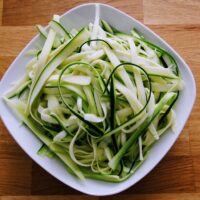Mr. Corn Visits Indiana
It’s that time of year again when my dear cousin, Roger, visits from Florida. He visits now because the sweet corn is amazing here in Indiana. For you newcomers to my blog post, he is known as Mr. Corn.
Why Mr. Corn? He loves corn more than anyone I know—even more than Mr. Non-Compliant (aka Hal). Roger says that corn on the cob in Florida isn’t fit to eat. So, he doesn’t.
This past weekend we gathered to enjoy a feast of just-picked LaPorte County corn.
We also had some grilled Greek chicken thighs, green beans, and tomatoes.
A total of 17 ears of corn dressed in organic butter and salt were devoured. (There were 6 corn eaters.) Mr. Corn and Mr. Non-Compliant had their fill, and as you can see by the picture, were calmly discussing who should get the last ear. 
Corn is one of the most popular cereal grains and is primarily composed of carbohydrates.
It also has a fair amount of fiber, mostly insoluble meaning it does not dissolve in water and is left intact and undigested.
Corn is a high-antioxidant food (a good thing), and is a source of protein, vitamin C, certain B vitamins, potassium, and magnesium.
Because it is a complex carbohydrate food that is also high in fiber, it supports steady energy levels, and ranks low or medium on the glycemic index scale.
It is naturally gluten free and can be a good substitute for wheat or other gluten-containing foods.
Sweet corn, the kind we usually eat, is still mostly non-GMO corn, however the percentage of GMO sweet corn grown is on the rise.
Field corn, the kind used to make corn oil, high fructose corn syrup, livestock feed, and many chemical ingredients that are added to packaged, processed foods, is usually genetically modified.
When purchasing corn tortillas or other corn products, look for non-GMO and organic on the label.
Here are a couple ways to enjoy corn that are healthier than eating it slathered with butter and salt.
Of course, Mr. Corn and Mr. Non-Compliant will tell you that these healthier versions are not fit to eat. 
Grilled Corn with Lime and Chili: Instead of butter, brush grilled corn with olive oil and sprinkle with a mix of chili powder, cumin, and a squeeze of fresh lime juice. The lime adds brightness, while the chili gives it a kick. Tajin seasoning would be a tasty substitute for the chili powder and cumin.
Parmesan & Black Pepper: A light dusting of finely grated Parmesan with fresh black pepper offers flavor without loads of butter.
Corn & Avocado Salad: Remove the kernels from the cob and toss them with diced avocado, cherry tomatoes, red onion, and cilantro. Drizzle with a little olive oil and lime juice for a light, fresh side dish.
Need some assistance figuring out the healthiest way for YOU to eat? Email me and we’ll figure it out together.
May you fully enjoy these last days of summer, along with some Indiana sweet corn.
Much love,
Health Coach Carol
“Corn on the cob is a carrier for salt and butter.”—Roger Ash








